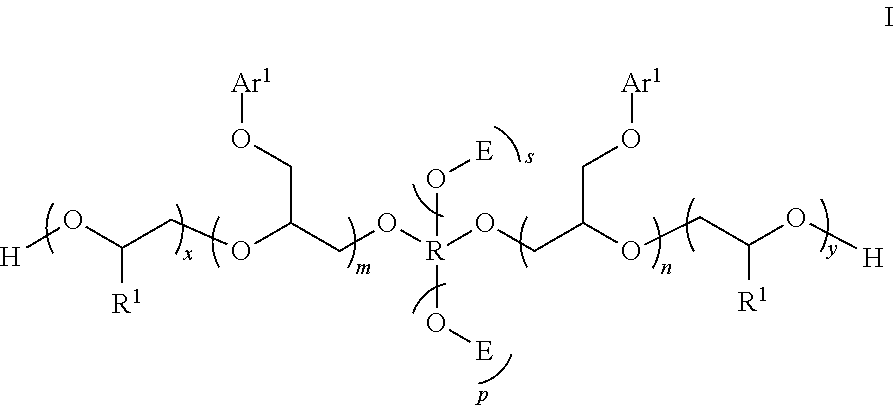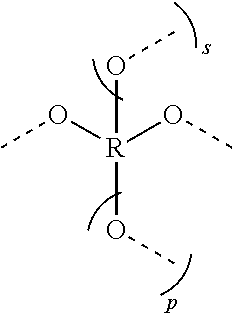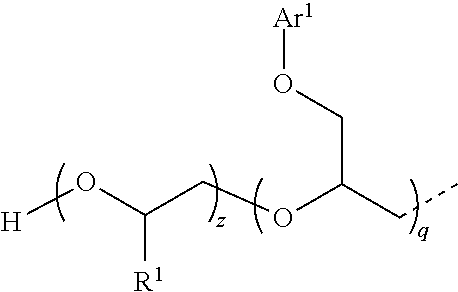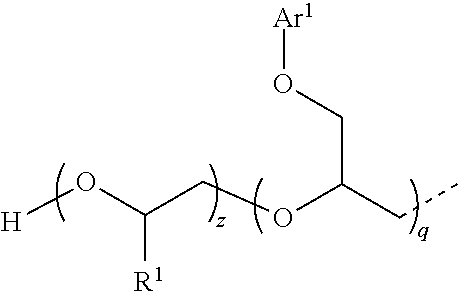Glycidyl Ether Alkoxylate Block Copolymers
Daugs; Edward D. ; et al.
U.S. patent application number 16/016769 was filed with the patent office on 2018-12-27 for glycidyl ether alkoxylate block copolymers. The applicant listed for this patent is Dow Global Technologies LLC, Rohm and Haas Company. Invention is credited to Edward D. Daugs, John J. Rabasco, Antony K. Van Dyk, Tianlan Zhang.
| Application Number | 20180371174 16/016769 |
| Document ID | / |
| Family ID | 62873142 |
| Filed Date | 2018-12-27 |












View All Diagrams
| United States Patent Application | 20180371174 |
| Kind Code | A1 |
| Daugs; Edward D. ; et al. | December 27, 2018 |
GLYCIDYL ETHER ALKOXYLATE BLOCK COPOLYMERS
Abstract
The present invention relates to a compound having the following structure I: ##STR00001## where Ar.sup.1, R, R.sup.1, E, m, n, x, y, p, and s are defined herein. The compound of the present invention is useful as an open time additive in waterborne coatings compositions, particularly waterborne paint compositions.
| Inventors: | Daugs; Edward D.; (Midland, MI) ; Rabasco; John J.; (Allentown, PA) ; Van Dyk; Antony K.; (Blue Bell, PA) ; Zhang; Tianlan; (Garnet Valley, PA) | ||||||||||
| Applicant: |
|
||||||||||
|---|---|---|---|---|---|---|---|---|---|---|---|
| Family ID: | 62873142 | ||||||||||
| Appl. No.: | 16/016769 | ||||||||||
| Filed: | June 25, 2018 |
Related U.S. Patent Documents
| Application Number | Filing Date | Patent Number | ||
|---|---|---|---|---|
| 62525342 | Jun 27, 2017 | |||
| Current U.S. Class: | 1/1 |
| Current CPC Class: | C09D 171/02 20130101; C08G 81/00 20130101; C08G 65/22 20130101; C08G 65/2606 20130101; C08G 65/2609 20130101 |
| International Class: | C08G 81/00 20060101 C08G081/00; C09D 171/02 20060101 C09D171/02 |
Claims
1. A compound having the following structure I: ##STR00009## where the fragment ##STR00010## is a structural unit of a C.sub.2-C.sub.60 linear or a C.sub.3-C.sub.60 branched or cyclic diol, triol, or tetrol optionally functionalized with O atoms or aryl groups or both, or a structural unit of an unsubstituted aromatic diol, triol, or tetrol, or a structural unit of an aromatic diol, triol, or tetrol substituted with from 1 to 3 C.sub.1-C.sub.6 alkyl groups; each R.sup.1 is independently H or C.sub.1-C.sub.6 alkyl; E is represented by the following structure: ##STR00011## m, n, and q are each independently from 1 to 20; x, y, and z are each independently from 1 to 50; p is 0 or 1; s is 0 or 1; and each Ar.sup.1 is independently unsubstituted phenyl or naphthyl, or phenyl or naphthyl substituted with from 1 to 3 C.sub.1-C.sub.6 alkyl groups.
2. The compound of claim 1 wherein p is 0; s is 0; each R.sup.1 is independently H or CH.sub.3; m and n are each independently in the range of from 1 to 10; and x and y are each independently in the range of from 5 to 30.
3. The compound of claim 1 wherein the fragment: ##STR00012## is a structural unit of a) a diol which is a C.sub.2-C.sub.20 alkane diol or an alkoxylated derivative thereof; or a polyoxyalkylene diol of the type H--(OCH.sub.2CH(R.sup.2)).sub.b--OH, where b is from 2 to 30, and R.sup.2 is H, methyl, or ethyl; or an aromatic diol or an alkoxylated derivative thereof; or b) a triol or an alkoxylated derivative thereof; or c) a tetrol or an alkoxylated derivative thereof.
4. The compound of claim 2 wherein the fragment: ##STR00013## is a structural unit of a polyoxyalkylene diol of the type H--(OCH.sub.2CH.sub.2).sub.b--OH, where b is from 2 to 30; and R.sup.2 is H.
5. The compound of claim 4 which has an M.sub.n in the range of from 1000 g/mole to 5000 g/mole; wherein each R.sup.1 is H; and b is 2, 3, or 4.
6. The compound of claim 5 where b is 3.
7. The compound of claim 1 which is represented by the following structure: ##STR00014## wherein m+n=4; and x+y=30; or m=1, n=1, and x+y=45; or m+n=6; and x+y=45.
8. The compound of claim 1 which is represented by the following structure: ##STR00015## where m+n+q=6; and x+y+z=40.
9. A coating composition comprising the compound of claim 1, a binder, a rheology modifier and at least one material selected from the group consisting of dispersants, pigments, defoamers, surfactants, solvents, extenders, coalescents, biocides, opaque polymers, and colorants.
Description
BACKGROUND OF THE INVENTION:
[0001] The present invention relates to glycidyl ether alkoxylate block copolymers, which are useful as open time additives in coatings formulations.
[0002] Government regulations and market movement continually drive toward zero volatile organic compounds (VOC) for coating formulations. Consequently, waterborne formulations that are free of volatile solvents and coalescents have become increasingly popular in the industry. Nevertheless, paint properties have been compromised due to this sea change; among them is open time, which is the period of time during which a freshly applied paint film can be reworked without leaving brush marks. In a solvent-borne system, open time is about 30 to 45 min; in a typical waterborne formulation, open time is on the order of 3 to 5 min.
[0003] U.S. Pat. No. 8,859,684 B2 discloses the preparation of phenyl glycidyl ether alkoxylates that are useful as open time additives in waterborne paint formulations. The best open times reported were 8 minutes using 2.5% by weight of the additive. However, the use of such high concentrations of a surfactant to achieve a marginal increase in open time is of limited commercial value due to the additive's contribution to the degradation of other properties of the final coating. Accordingly, there is an ongoing need in the art to find an additive for waterborne formulations that significantly increases open time over currently available additives without degrading other properties of the final coating, such as film adhesive and cohesive strength, hardness, block resistance, early blister resistance, scrub and wash resistance, stain resistance, and mar resistance.
SUMMARY OF THE INVENTION:
[0004] The present invention addresses a need in the art by providing a compound having the following structure I:
##STR00002##
[0005] where the fragment
##STR00003##
[0006] is a structural unit of a C.sub.2-C.sub.60 linear or a C.sub.3-C.sub.60 branched or cyclic diol, triol, or tetrol optionally functionalized with O atoms or aryl groups or both, or a structural unit of an unsubstituted aromatic diol, triol, or tetrol, or a structural unit of an aromatic diol, triol, or tetrol substituted with from 1 to 3 C.sub.1-C.sub.6 alkyl groups;
[0007] each R.sup.1 is independently H or C.sub.1-C.sub.6 alkyl;
[0008] E is represented by the following structure:
##STR00004##
[0009] m, n, and q are each independently from 1 to 20; x, y, and z are each independently from 1 to 50; p is 0 or 1; s is 0 or 1; and
[0010] each Ar.sup.1 is independently unsubstituted phenyl or naphthyl, or phenyl or naphthyl substituted with from 1 to 3 C.sub.1-C.sub.6 alkyl groups.
[0011] The compound of the present invention is useful as an open time additive in waterborne coatings compositions, particularly waterborne paint compositions.
DETAILED DESCRIPTION OF THE INVENTION
[0012] The present invention is a compound having the following structure I:
##STR00005##
[0013] where the fragment
##STR00006##
[0014] is a structural unit of a C.sub.2-C.sub.60 linear or a C.sub.3-C.sub.60 branched or cyclic diol, triol, or tetrol optionally functionalized with O atoms or aryl groups or both, or a structural unit of an unsubstituted aromatic diol, triol, or tetrol, or a structural unit of an aromatic diol, triol, or tetrol substituted with from 1 to 3 C.sub.1-C.sub.6 alkyl groups;
[0015] each R.sup.1 is independently H or C.sub.1-C.sub.6 alkyl;
[0016] E is represented by the following structure:
##STR00007##
[0017] m, n, and q are each independently from 1 to 20; x, y, and z are each independently from 1 to 50; p is 0 or 1; s is 0 or 1; and
[0018] each Ar.sup.1 is independently unsubstituted phenyl or naphthyl, or phenyl or naphthyl substituted with from 1 to 3 C.sub.1-C.sub.6 alkyl groups.
[0019] Examples of suitable diols useful for preparing the compound of the present invention include C.sub.2-C.sub.20 alkane diols such as 1,2-ethane diol, 1,3-propane diol, 1,4-butane diol, and 1,6-hexane diol, as well as alkoxylated derivatives of these diols; polyoxyalkylene diols of the type H--(OCH.sub.2CH(R.sup.2)).sub.b--OH, where b is from 2 to 30, preferably 2, 3, or 4; and more preferably 3; and R.sup.2 is H, methyl, or ethyl; aromatic diols such as 1,4-benzenedimethanol, catechol, resorcinol, and hydroquinone, as well as alkoxylated derivatives of these diols.
[0020] Example of suitable triols include trimethylolpropane, phloroglucinol, hydroxyquinol, pyrogallol, and glycerol, as well as alkoxylated derivatives of these triols; examples of suitable tetrols are pentaerythritol and benzenetetrol and alkoxylated derivatives of these tetrols.
[0021] Each Ar.sup.1 is preferably independently phenyl, cresyl, or p-t-butylphenyl; preferably, m and n are each independently in the range of from 1, more preferably from 2, to 10, more preferably to 6, and most preferably to 5. Preferably, x and y are each independently from 5, more preferably from 10, to 30, more preferably to 25. Preferably, p and s are both 0.
[0022] Because each R.sup.1 is independently H or C.sub.1-C.sub.6-alkyl, the alkylene oxide groups ((OCH.sub.2CHR.sup.1).sub.n) can be random or block copolymers. Preferably, each R.sup.1 is independently H, methyl, or ethyl; more preferably H or methyl; most preferably each R.sup.1 is H.
[0023] Examples of subclasses of compounds of the present invention are represented by the following structures:
##STR00008##
[0024] where, for Ia, m+n=4; and x+y=30; for Ib, m=1, n=1, and x+y=45; for Ic, m+n=6; and x+y=45; and for Id, m+n+q=6; and x+y+z=40.
[0025] The compound of the present invention can be conveniently prepared by first contacting a diol, triol, or tetrol with an aryl glycidyl ether in the presence of a catalytic amount of a suitable base such as KOH, under conditions sufficient to prepare an aryl glycidyl ether oligomer intermediate, then contacting the intermediate with an alkylene oxide such as ethylene oxide under conditions sufficient to form the desired compound I. Preferably, the polyol is a diol, more preferably triethylene glycol. The aryl alcohol is preferably phenol, p-t-butylphenol, or a cresol, and the aryl glycidyl ether is preferably phenyl glycidyl ether, p-t-butylphenol glycidyl ether, or a cresyl glycidyl ether.
[0026] The number average molecular weight (M.sub.n) of the compound, as determined by matrix assisted laser desorption ion mass spectrometry (MALDI-MS), is preferably in the range of from 300, more preferably from 500, and most preferably from 1000 g/mol, to preferably 20,000, more preferably to 15,000, more preferably to 10,000, and most preferably to 5,000 g/mol.
[0027] The compound of the present invention can be used as an open time additive for a coatings composition, which includes binder, rheology modifier, and any or all of the following materials: dispersants, pigments, defoamers, surfactants, solvents, extenders, coalescents, biocides, opaque polymers, and colorants.
EXAMPLES
Example 1
Preparation of Phenyl Glycidyl Ether Ethoxylate Block Copolymer Ia
[0028] A 500-mL round-bottom flask equipped with a temperature controlled heating mantle, an addition funnel, a reflux/distillation head, and overhead stirrer was charged with triethyleneglycol (61.13 g, 0.407 mole) and KOH flakes (1.18 g, 90% pure). Phenyl glycidyl ether (247.47 g, 1.65 moles) was added over 5 h at 100.degree. C., after which time the mixture was cooled to room temperature. A portion of the resultant intermediate (86.7 g) was charged into a conical bottom 2-L Parr reactor. The reactor was sealed, pressure checked, purged with N.sub.2, then heated to 120.degree. C. Ethylene oxide (151.0 g) was added at a rate of 0.2 to 0.3 g/min. The mixture was held at 120.degree. C. for 1 h, then cooled to 60.degree. C. before unloading the product (652.7 g). The reaction product was mixed with 0.18 g of acetic acid to for, product Ia (m+n=4; and x+y=30.)
Example 2
Preparation of Phenyl Glycidyl Ether Ethoxylate Block Copolymer Ib
[0029] A 500-mL round-bottom flask equipped with a temperature controlled heating mantle, an addition funnel, a reflux/distillation head and overhead stirrer was charged with triethyleneglycol (102.69 g, 0.711 mole) and KOH flakes (2.09 g, 90% pure). Phenyl glycidyl ether (206.26 g, 1.37 moles) was added over 8 h at 95.degree. C. then cooled to room temperature. The mixture was stirred overnight at 95.degree. C., then cooled. A portion of the intermediate was removed (149.5 g, Intermediate A), and the remainder was reheated to 95.degree. C. A second portion of phenyl glycidyl ether (220.55 g, 1.47 moles) was added over 4 h. The mixture was stirred overnight at 95.degree. C., then cooled to unload a second intermediate (333.5 g, Intermediate B). A portion of Intermediate A (49.4 g) was charged into a conical bottom 2-L Parr reactor. The reactor was sealed, pressure checked, purged with N.sub.2, then heated to 120.degree. C. Ethylene oxide (218.2 g) was added at a rate of 0.3 to 1 g/min. The mixture was held at 120.degree. C. for 1.5 h, then cooled to 70.degree. C. before unloading the product (260.2 g). The reaction product was mixed with 0.21 g of acetic acid to form product Ib (m=1, n=1, and x+y=45).
Example 3
Preparation of Phenyl Glycidyl Ether Ethoxylate Block Copolymer Ic
[0030] A portion of Intermediate B from Example 2 (158.8 g) was charged into a conical bottom 2-L Parr reactor. The reactor was sealed, pressure checked, purged with N.sub.2, then heated to 120.degree. C. Ethylene oxide (298.5 g) was added at a rate of 0.3 to 1 g/min. The mixture was held at 120.degree. C. for 1.5 h, then cooled to 80.degree. C. before unloading the product (447.0 g). The reaction product was mixed with 0.17 g of acetic acid to form Ic (m+n=6; and x+y=45)
Example 4
Preparation of Phenyl Glycidyl Ether Ethoxylate Block Copolymer Id
[0031] A 500-mL round-bottom flask equipped with a temperature controlled heating mantle, an addition funnel, a reflux/distillation head and overhead stirrer was charged with 1,1,1-tris(hydroxymethyl)propane (TMP, 59.59 g, 0.444 mole) and heated to 70.degree. C. before addition of KOH flakes (2.75 g, 90% pure). The solution was heated to 95.degree. C. whereupon phenyl glycidyl ether (400.0 g, 2.66 moles) was added over 4 h. The mixture was stirred overnight at 90.degree. C., then cooled. A portion of this intermediate (221.9 g) was charged into a conical bottom 2-L Parr reactor. The reactor was sealed, pressure checked, purged with N.sub.2, then heated to 120.degree. C. Ethylene oxide (378.0 g) was added at a rate of 1 to 2 g/min. The mixture was held at 120.degree. C. for 1.5 h, then cooled to 80.degree. C. before unloading the product (561.3 g). The reaction product was mixed with 1.5 g of acetic acid to form Id (m+n+q=6; and x+y+z=40).
[0032] M.sub.n Measurement of Additive by MALDI-MS
[0033] MALDI mass spectra were acquired on a Bruker Daltonics ultraflex MALDI-TOF mass spectrometer equipped with a nitrogen laser (.lamda.=337 nm). In the MALDI experiment, 20 mg of 2,5-dihydroxybenzoic acid was dissolved in 1 mL of THF as the MALDI matrix. The sample solution in MeOH was premixed with the matrix solution at a ratio of 1:20. To facilitate ionization of the species in the sample mixture, NaI was added into the sample/matrix mixture. A 0.3 .mu.l sample of the mixture was then placed on the sample plate and was air dried for MALDI-MS analysis. Reflectron mode was selected in the analysis to enhance the resolution of the mass spectra.
[0034] Paint Formulation:
[0035] Paint formulations with and without open time additive were prepared in accordance with Table 1.
TABLE-US-00001 TABLE 1 Paint Formulation with Open Time Additive Material Name Pounds Gallons RHOPLEX .TM. HG-706 Binder 584.1 66.0 BYK-024 Defoamer 1.0 0.1 Propylene Glycol 4.3 0.5 TRITON .TM. X-100 Surfactant 4.4 0.5 Water 16.7 2.0 KATHON .TM. LX 1.5% Biocide 1.5 0.2 TAMOL .TM. 2002 Dispersant 2.0 0.2 Ammonia (28%) 1.0 0.1 Ti-Pure R-746 TiO.sub.2 285.0 14.7 Water 20.0 2.4 Texanol Coalescent 7.9 1.0 ACRYSOL .TM. RM-2020E Rheology Modifier 20.0 2.3 ACRYSOL .TM. RM-725 Rheology Modifier 3.0 0.4 BYK-024 Defoamer 2.0 0.2 Open Time Additive (40% aq.) 25.8 2.84 Water 79 9.5 Totals 1030 100
[0036] RHOPLEX, TRITON, KATHON, TAMOL, and ACRYSOL are all Trademarks of The Dow Chemical Company or its Affiliates.
[0037] Table 2 shows the impact on open time when using the additives of the present invention.
TABLE-US-00002 TABLE 2 Open Time Data Ex. No. Additive M.sub.n MALDI-MS (g/mole) Open Time (min) Example 1 Ia 1854 15.0 Example 2 Ib 2175 11.0 Example 3 Ic 2690 13.0 Example 4 Id 2617 9.0 Comp. 1 none NA 6.0
[0038] The data demonstrate a marked increase in open time for a paint formulation containing the additive of the present invention.
* * * * *















XML
uspto.report is an independent third-party trademark research tool that is not affiliated, endorsed, or sponsored by the United States Patent and Trademark Office (USPTO) or any other governmental organization. The information provided by uspto.report is based on publicly available data at the time of writing and is intended for informational purposes only.
While we strive to provide accurate and up-to-date information, we do not guarantee the accuracy, completeness, reliability, or suitability of the information displayed on this site. The use of this site is at your own risk. Any reliance you place on such information is therefore strictly at your own risk.
All official trademark data, including owner information, should be verified by visiting the official USPTO website at www.uspto.gov. This site is not intended to replace professional legal advice and should not be used as a substitute for consulting with a legal professional who is knowledgeable about trademark law.